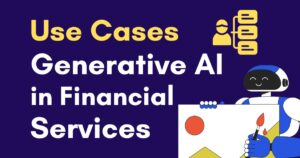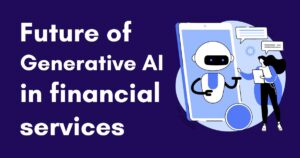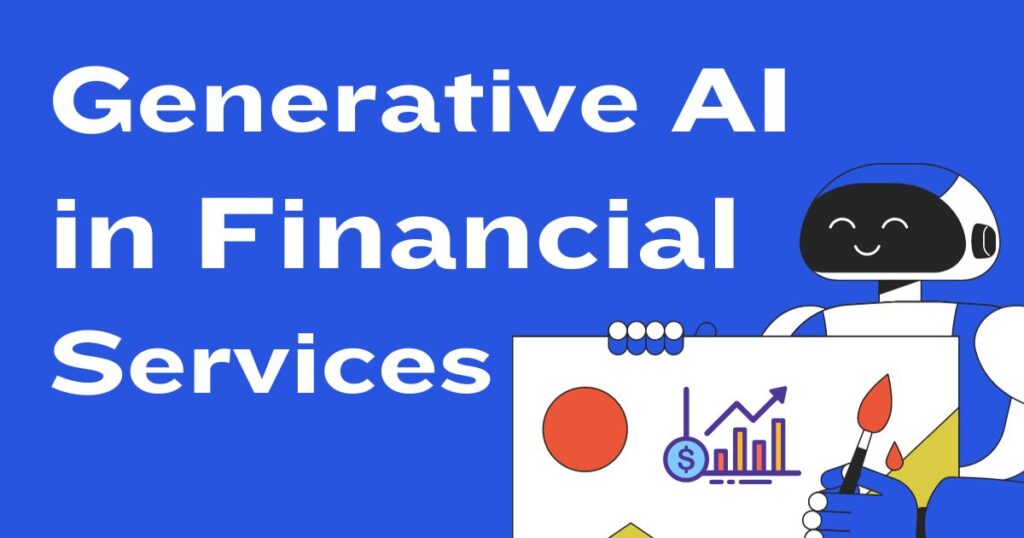In the labyrinth of modern finance, where numbers and algorithms intertwine, a groundbreaking force is emerging, captivating the gaze of astute innovators and seasoned investors alike. Welcome to the realm of Generative AI in Financial Services – a technological juggernaut poised to reshape the industry’s landscape. This amalgamation of financial wizardry and cutting-edge artificial intelligence is no longer confined to the realm of science fiction; it’s now steering the financial ship towards uncharted waters, brimming with potential.
As the world hurtles towards an AI-infused future, this blog promises to be your guiding light, shedding light on the myriad Advantages of employing Generative AI in the financial arena. But we won’t stop there. Prepare to delve into the thrilling depths of its Future, where possibilities seem endless. Our expedition will also unveil the most intriguing Use Cases, revealing how this transformative technology can revamp portfolio management, risk assessment, and customer service. So fasten your seatbelt, dear reader, because a financial revolution is imminent, and it begins right here.
[ez-toc]
Introduction: Generative AI in Financial Services
Definition of Generative AI in Financial Services
In the ever-evolving landscape of financial services, Generative AI stands as a transformative force. At its core, Generative AI is an advanced branch of artificial intelligence that empowers machines to create content, make predictions, and generate data autonomously. In the context of financial services, Generative AI is all about harnessing the power of machine learning to automate tasks, drive decision-making, and develop innovative solutions. It’s the marriage of financial acumen and technological prowess.
The Significance of Generative AI in Fintech
The significance of Generative AI in the realm of fintech cannot be overstated. As technology continually reshapes financial services, the ability to generate, predict, and create becomes a vital competitive advantage. Generative AI holds the promise of greater efficiency, improved risk management, and enhanced customer experiences. It’s a pivotal element in propelling the financial industry into the future, where automation, data-driven insights, and personalization reign supreme.
Understanding Generative AI

Explanation of Generative AI and Its Functioning
Generative AI is, fundamentally, the manifestation of machine learning models capable of creating content. At its heart, Generative AI relies on neural networks to learn from vast datasets and then produce new, contextually relevant information. By understanding patterns, these AI models generate text, images, and more. In financial services, this manifests as automating report generation, creating personalized financial advice, and even producing content for marketing and communication.
Differentiating Generative AI from Other AI Technologies
To grasp the uniqueness of Generative AI, it’s essential to differentiate it from other AI technologies. While other AI systems, like supervised or unsupervised learning, may excel in classification and clustering, Generative AI’s forte lies in creativity. It can create what hasn’t been seen before, making it a crucial tool for financial innovation. Unlike rule-based systems, it doesn’t rely on predefined conditions, allowing it to adapt and evolve with changing data and demands.
Advantages of Generative AI in Financial Services
Generative AI offers a treasure trove of advantages for the financial industry.
Firstly, it enhances data-driven decision-making. By generating insights and forecasts, it aids in risk assessment, investment strategies, and market analysis.
Secondly, it streamlines operations. The automation of report generation, document summarization, and customer communication reduces human effort and minimizes errors.
Thirdly, it personalizes customer experiences. Generative AI tailors recommendations, financial advice, and communication to each individual’s unique preferences and financial goals.
Fourthly, it bolsters fraud detection and security. Its predictive capabilities can identify anomalies and suspicious activities in real time, strengthening cybersecurity measures.
Unprecedented Use Cases of Generative AI in Financial Services

In the ever-evolving landscape of financial services, cutting-edge technologies are reshaping the industry. One such technological marvel is Generative AI, which has found remarkable applications in various facets of finance. This article delves into the innovative use cases of Generative AI, exploring how it is transforming the world of finance.
Fraud Detection and Prevention
1. Utilizing Generative AI to detect previously unseen fraud patterns
Fraud detection has long been a critical concern for financial institutions. The advent of Generative AI has ushered in a new era of vigilance. With the ability to analyze vast datasets and recognize intricate patterns, Generative AI has become a formidable ally in identifying fraud.
This technology excels at detecting previously unseen fraud patterns that often elude conventional rule-based systems. By understanding the nuances of transactions and customer behavior, Generative AI can unearth irregularities that may signal fraudulent activity.
Moreover, it operates in real-time, swiftly flagging suspicious transactions and reducing the time window for potential fraud to occur. It’s like having a vigilant sentry that never sleeps, guarding financial assets against even the most sophisticated threats.
2. Enhancing accuracy and speed in fraud prevention systems
Generative AI is not merely about detection; it also enhances the accuracy and speed of fraud prevention systems. Its predictive capabilities allow financial institutions to take preemptive action, preventing fraudulent activities before they can cause damage.
By continuously learning and adapting, Generative AI can fine-tune its algorithms to reduce false positives and negatives. This means fewer innocent transactions being flagged as suspicious and a higher detection rate for actual fraud attempts.
In the race against time, where every second counts, the speed at which Generative AI processes and analyzes data is unparalleled. This rapid response not only safeguards financial assets but also upholds the trust and confidence of customers.
Customized Financial Planning and Investment Management
1. Leveraging Generative AI to generate personalized investment portfolios
Gone are the days of generic investment advice. Generative AI empowers financial institutions to craft tailored investment portfolios for individual clients. It takes into account a multitude of factors, including risk tolerance, financial goals, and market conditions, to create a portfolio that suits the unique needs of each client.
This level of personalization is a game-changer in the world of financial planning. It maximizes returns and minimizes risks, aligning the investment strategy precisely with the client’s aspirations.
2. Improving financial planning recommendations for individuals
Generative AI doesn’t stop at portfolio creation; it also enhances financial planning recommendations. By analyzing a client’s financial history and future goals, it can offer insights and advice that are not only comprehensive but also forward-looking.
This goes above and beyond the standard buy, hold, or sell advice. Generative AI can identify opportunities, optimize tax strategies, and even suggest changes in financial behavior to achieve long-term objectives.
Risk Assessment and Management
1. Analyzing complex data sets using Generative AI for enhanced risk assessment
Risk assessment in the financial world is no longer reliant on simple calculations. Generative AI can analyze complex data sets, integrating numerous variables that were previously impossible to consider simultaneously.
This technology can predict risks associated with investments, loans, or any financial decision, offering a level of sophistication that was once unattainable. It assesses not just the obvious factors but also the hidden, interconnected variables that could impact the financial landscape.
2. Mitigating risk through predictive modeling and scenario analysis
Once risks are identified, Generative AI doesn’t stop there. It aids in risk mitigation through predictive modeling and scenario analysis. It can simulate various scenarios, helping financial institutions understand the potential consequences of different decisions.
This empowers institutions to make informed choices, optimizing their risk exposure. It’s like having a crystal ball that shows you the potential future of your financial decisions.
Customer Service and Experience Enhancement
1. Deploying Generative AI to offer personalized customer interactions
In the realm of customer service, Generative AI is revolutionizing the way financial institutions interact with their clients. By analyzing past interactions and understanding customer preferences, it enables highly personalized customer experiences.
Customers are no longer treated as mere numbers. Generative AI ensures that interactions are tailored to individual needs and preferences, creating a sense of being valued and understood.
2. Improving customer satisfaction and loyalty
Enhanced customer service increases client loyalty and satisfaction. Generative AI plays a pivotal role in building strong, lasting relationships between financial institutions and their clients. Happy customers are more likely to stay, invest, and refer others.
Generative AI’s ability to predict customer needs and offer proactive solutions is akin to having a personal financial advisor available 24/7.
Algorithmic Trading and Predictive Analytics
1. Using Generative AI to identify profitable trading strategies
Algorithmic trading has become a staple in financial markets, and Generative AI takes it to the next level. By analyzing massive datasets and market conditions in real-time, it identifies profitable trading strategies with remarkable accuracy.
Traders are no longer reliant solely on human intuition. Generative AI offers data-driven insights that can inform trading decisions, making the financial markets more accessible and less risky.
2. Enhancing predictive analytics to predict market trends with increased accuracy
Predictive analytics is a cornerstone of successful financial decision-making. Generative AI enhances this by offering unprecedented accuracy in predicting market trends. It sifts through terabytes of data, discerning subtle signals that human analysts might overlook.
The ability to foresee market movements with precision is a game-changer for traders and investors. It allows them to stay ahead of the curve and make timely, informed decisions.
Challenges and Limitations of Generative AI in Financial Services
Generative AI has undoubtedly made significant strides in the financial services sector, revolutionizing various aspects of the industry. However, like any technological advancement, it is not without its challenges and limitations.
Ethical considerations and privacy concerns
In the realm of generative AI, ethical considerations and privacy concerns loom large. While these systems can generate vast amounts of data and text, there is a fine line between leveraging this technology for innovation and infringing upon individuals’ privacy rights.
On one hand, the use of generative AI can lead to more personalized financial services, which, in turn, can help customers make better financial decisions. On the other hand, the collection and analysis of sensitive financial information raise significant ethical dilemmas. How can financial institutions strike the right balance between utilizing AI for customer benefit and protecting their personal information?
Moreover, the potential for AI-generated content to spread misinformation or engage in malicious activities is a growing concern. We must address these ethical concerns through robust regulatory frameworks and a commitment to transparency.
Ensuring regulatory compliance and transparency
Financial services, by their nature, are highly regulated. Generative AI must adhere to these regulations, and this presents a challenge due to the complexity of AI systems. Ensuring that AI systems comply with laws and regulations, such as Know Your Customer (KYC) and Anti-Money Laundering (AML) requirements, is essential.
Transparency is key. Financial institutions must be able to explain how their generative AI systems arrive at specific decisions or recommendations. This not only satisfies regulatory requirements but also builds trust among customers and stakeholders.
In the face of these challenges, collaboration between regulatory bodies and the financial industry is crucial. A unified effort can lead to more effective regulation of generative AI in financial services.
Limitations in handling complex financial data
Generative AI systems have come a long way in handling complex financial data, but they are not infallible. Complex financial data, which includes unstructured information, market trends, and economic indicators, can sometimes overwhelm AI models. They may struggle to interpret nuanced financial news or rapidly changing market conditions.
It is vital to recognize that generative AI is a tool, not a panacea. Human expertise remains indispensable in interpreting the subtleties and nuances of financial data. Collaboration between AI and human experts is an ideal way to overcome these limitations.
The Future of Generative AI in financial services

As we delve into the future of generative AI in financial services, it’s clear that the potential for advancements and innovations is vast.
Potential advancements and innovations in Generative AI for financial services
The future of generative AI in fintech is promising. Advancements in machine learning and natural language processing are likely to improve the accuracy and capabilities of AI systems. These systems will become more adept at understanding complex financial jargon, identifying market trends, and providing customized financial advice.
Additionally, generative AI may play a pivotal role in risk assessment, fraud detection, and portfolio optimization. These advancements will enable financial institutions to enhance their services and minimize risks more effectively.
Collaborations between financial institutions and AI providers
Collaborations between financial institutions and AI providers are expected to intensify. Financial institutions are increasingly looking to partner with AI technology companies to harness the full potential of generative AI. Such partnerships can expedite the development and deployment of AI solutions, driving innovation and providing a competitive edge.
These collaborations are not limited to large corporations. Smaller fintech startups are also likely to enter into partnerships with AI providers, democratizing access to advanced technology and fostering innovation in the sector.
The role of human expertise in conjunction with Generative AI
While AI is advancing rapidly, human expertise remains irreplaceable. The role of human experts in conjunction with generative AI is integral. AI can analyze vast datasets, identify patterns, and make predictions, but human judgment, empathy, and ethical considerations are irreplaceable.
In the future, financial institutions will increasingly focus on creating a symbiotic relationship between generative AI and human experts. AI will handle data-intensive tasks, while humans will provide the critical thinking, strategic insight, and personalized guidance that customers value.
Conclusion: Generative AI in financial services
Recap of the potential of Generative AI in financial services
Generative AI holds immense potential in transforming various aspects of financial services, from risk assessment to customer service and investment strategies. Its ability to process vast amounts of data with speed and accuracy is a game-changer.
Encouraging further exploration and implementation in the Fintech industry
The Fintech industry must actively explore and invest in Generative AI to stay competitive and meet the ever-increasing demands of consumers. Collaboration, regulatory framework, and education are the keys to unlocking its potential.
Embracing Generative AI to revolutionize the financial landscape
Embracing Generative AI is not an option but a necessity to revolutionize the financial landscape. It’s time for financial institutions to leverage this technology to improve their services and stay ahead of the curve. The future of finance is powered by Generative AI, and the possibilities are limitless.



